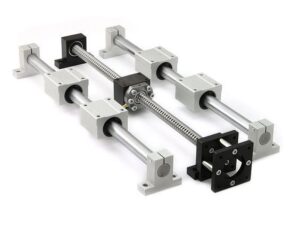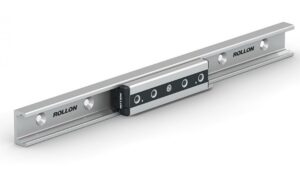Outline for Long-Form Article on “Roller Guide Rails”
| Heading | Sub-Headings |
|---|---|
| Introduction to Roller Guide Rails | Why they are vital in precision engineering |
| What Are Roller Guide Rails | Definition and main components |
| History of Roller Guide Rails | From sliding guides to advanced rollers |
| How Roller Guide Rails Work | Principles of guided linear rolling motion |
| Types of Roller Guide Rails | Profiled rails, heavy-duty rails, compact rails |
| Roller Guide Rails vs. Ball Guide Rails | Key differences in performance |
| Advantages of Roller Guide Rails | Rigidity, load capacity, smooth motion |
| Limitations of Roller Guide Rails | Cost, contamination risks, installation challenges |
| Applications in CNC Machines | Milling, lathes, routers |
| Uses in Robotics and Automation | Assembly, pick-and-place, cobots |
| Roller Guide Rails in Conveyors | Material handling and logistics |
| Applications in Medical Equipment | Imaging, surgical robotics |
| Uses in Aerospace and Defense | High-load precision systems |
| Applications in Automotive Industry | Assembly lines, robotic welding |
| Materials for Roller Guide Rails | Hardened steel, stainless steel, coated rails |
| Design Considerations | Load, accuracy, speed, and environment |
| Installation of Roller Guide Rails | Alignment, mounting, lubrication |
| Lubrication and Maintenance | Extending lifespan and performance |
| Troubleshooting Common Issues | Misalignment, vibration, uneven wear |
| Future of Roller Guide Rails | Smart sensors, IoT integration |
| Custom Roller Guide Rails | Tailored designs for niche industries |
| Cost and Investment Factors | Pricing elements explained |
| Choosing the Right Roller Guide Rails | Factors for selection |
| Roller Guide Rails | Deep dive focus section |
| FAQs | Common questions answered |
| Conclusion | Final thoughts on roller guide rails |
Introduction to Roller Guide Rails
In industries where precision and reliability are non-negotiable, roller guide rails have become the gold standard. From CNC machines to robotics, these systems enable accurate linear motion under heavy loads while minimizing vibration. They may not be the most glamorous components, but without them, advanced automation and precision engineering would be nearly impossible.
What Are Roller Guide Rails
A roller guide rail is a linear motion system where a rail serves as the guiding path, and a block containing rollers moves along it. Unlike ball-bearing systems, roller designs use cylindrical or needle rollers, which provide higher rigidity, better load distribution, and smoother motion. This makes them particularly suited for heavy-duty applications.
History of Roller Guide Rails
The story of roller guides begins with simple sliding systems that caused excessive wear and friction. Over time, engineers introduced rolling elements like balls, which improved efficiency. But as industries demanded even greater rigidity and higher load capacity, roller guide rails emerged. Today, they are widely used in demanding fields like aerospace, automotive, and medical technology.
How Roller Guide Rails Work
The principle is simple yet highly effective. Rollers in the carriage block move along profiled grooves of the rail. Because contact is line-based rather than point-based, the system distributes loads more evenly. This reduces deflection and provides superior stiffness compared to ball-bearing rails. The result? High precision, even at high speeds or under heavy loads.
Types of Roller Guide Rails
Several variations exist to suit different needs:
Profiled Roller Rails – High precision and rigidity.
Compact Roller Rails – Smaller, for tight installations.
Heavy-Duty Roller Rails – Built for machines with extreme loads.
Crossed Roller Rails – Provide multi-directional rigidity.
Roller Guide Rails vs. Ball Guide Rails
The comparison often comes down to application:
Ball Guide Rails – Lower cost, smoother at low loads, common in lighter CNCs.
Roller Guide Rails – More rigid, handle heavier loads, better for high-precision and industrial tasks.
If accuracy and durability under heavy conditions are the priorities, rollers outperform balls every time.
Advantages of Roller Guide Rails
Key benefits include:
High Rigidity – Resists deflection under heavy forces.
Load Capacity – Handles greater static and dynamic loads.
Smooth Motion – Ensures vibration-free movement.
Durability – Longer service life under stress.
Versatility – Works across multiple industries.
Limitations of Roller Guide Rails
Despite their strengths, they do present challenges:
Higher cost compared to ball-based rails.
Require clean operating conditions—debris can reduce lifespan.
Installation demands precise alignment.
However, these issues are often outweighed by their performance in demanding environments.
Applications in CNC Machines
CNC machines use roller guide rails for their precision and rigidity. In milling machines, they ensure the spindle moves accurately under heavy cutting forces. In lathes and routers, they maintain smooth tool paths, reducing chatter and improving surface finish.
Uses in Robotics and Automation
In robotics, roller rails allow robots to move with precision and repeatability. Whether in automotive assembly lines or delicate medical automation, they provide the stability needed for accurate positioning.
Roller Guide Rails in Conveyors
Material handling systems use roller rails to guide loads smoothly along production lines. They reduce friction, lower energy costs, and increase conveyor durability, making them essential in packaging and logistics.
Applications in Medical Equipment
Medical devices require both reliability and cleanliness. Stainless steel roller guide rails are used in imaging machines, surgical robots, and lab automation equipment, where accuracy can directly impact patient outcomes.
Uses in Aerospace and Defense
The aerospace sector demands high precision under intense conditions. Roller guide rails support aircraft assembly, satellite testing, and missile guidance systems, where tolerances must be exact.
Applications in Automotive Industry
Automotive plants rely on roller rails in robotic welding, painting, and assembly systems. They provide the accuracy needed for repetitive, high-speed processes, ensuring consistency in mass production.

Materials for Roller Guide Rails
Hardened Steel – Provides rigidity and strength.
Stainless Steel – Resistant to corrosion in clean or harsh environments.
Coated Rails – Offer additional protection from wear or chemicals.
Design Considerations
When designing with roller rails, engineers must evaluate:
Load capacity (static and dynamic).
Required precision levels.
Operating speeds.
Environmental conditions (dust, chemicals, humidity).
Installation of Roller Guide Rails
Correct installation is critical:
Ensure the base surface is flat and clean.
Align rails using dial gauges or laser alignment tools.
Torque bolts to recommended specifications.
Mount roller blocks carefully.
Lubricate before running.
Lubrication and Maintenance
Regular lubrication reduces wear and extends lifespan. Automatic lubrication systems are often used in industrial machines. Maintenance also involves inspecting for smooth travel, unusual noise, or wear marks.
Troubleshooting Common Issues
Noise and Vibration – Usually from poor lubrication or contamination.
Misalignment – Causes uneven wear and reduced accuracy.
Sticking or Rough Motion – Indicates dirt or debris in the rail system.
Premature Failure – Often from overloading or poor installation.
Future of Roller Guide Rails
The future includes IoT-enabled roller guide rails with built-in sensors that monitor load, temperature, and wear. Predictive maintenance will replace routine checks, reducing downtime and costs. Lightweight materials and self-lubricating designs are also on the horizon.
Custom Roller Guide Rails
Some industries need specialized solutions, such as miniature rails for medical devices or extra-large rails for aerospace. Manufacturers now provide custom coatings, dimensions, and integrated sensors.
Cost and Investment Factors
Factors influencing cost include:
Rail size and length.
Load rating and precision grade.
Material and coatings.
Brand and country of manufacture.
Although expensive, their durability and accuracy justify the investment.
Choosing the Right Roller Guide Rails
To select the best rail system:
Define the application (CNC, conveyor, robotics).
Calculate load requirements.
Consider environmental conditions.
Factor in maintenance capabilities.
Roller Guide Rails
Ultimately, roller guide rails deliver the stability and accuracy industries need. Whether in CNC machining, robotics, or material handling, they provide unmatched rigidity and durability, ensuring productivity and precision.
FAQs
What are roller guide rails used for?
They enable precise, smooth linear motion in CNC machines, conveyors, and automation.
Are roller rails better than ball rails?
Yes, for heavy loads and high rigidity, roller rails outperform ball rails.
Do they need lubrication?
Absolutely. Lubrication reduces wear and ensures smooth performance.
How long do roller guide rails last?
With proper care, they can last for years, even under demanding use.
Can roller rails be customized?
Yes, many industries require tailored solutions for unique applications.
Which industries use them most?
Manufacturing, aerospace, automotive, robotics, and medical technology.
Conclusion
Roller guide rails may be hidden inside machines, but their impact is massive. By providing rigidity, precision, and smooth motion, they keep industries moving forward with accuracy and efficiency. As technology evolves, smart and durable roller guide rails will continue shaping the future of automation and engineering.



